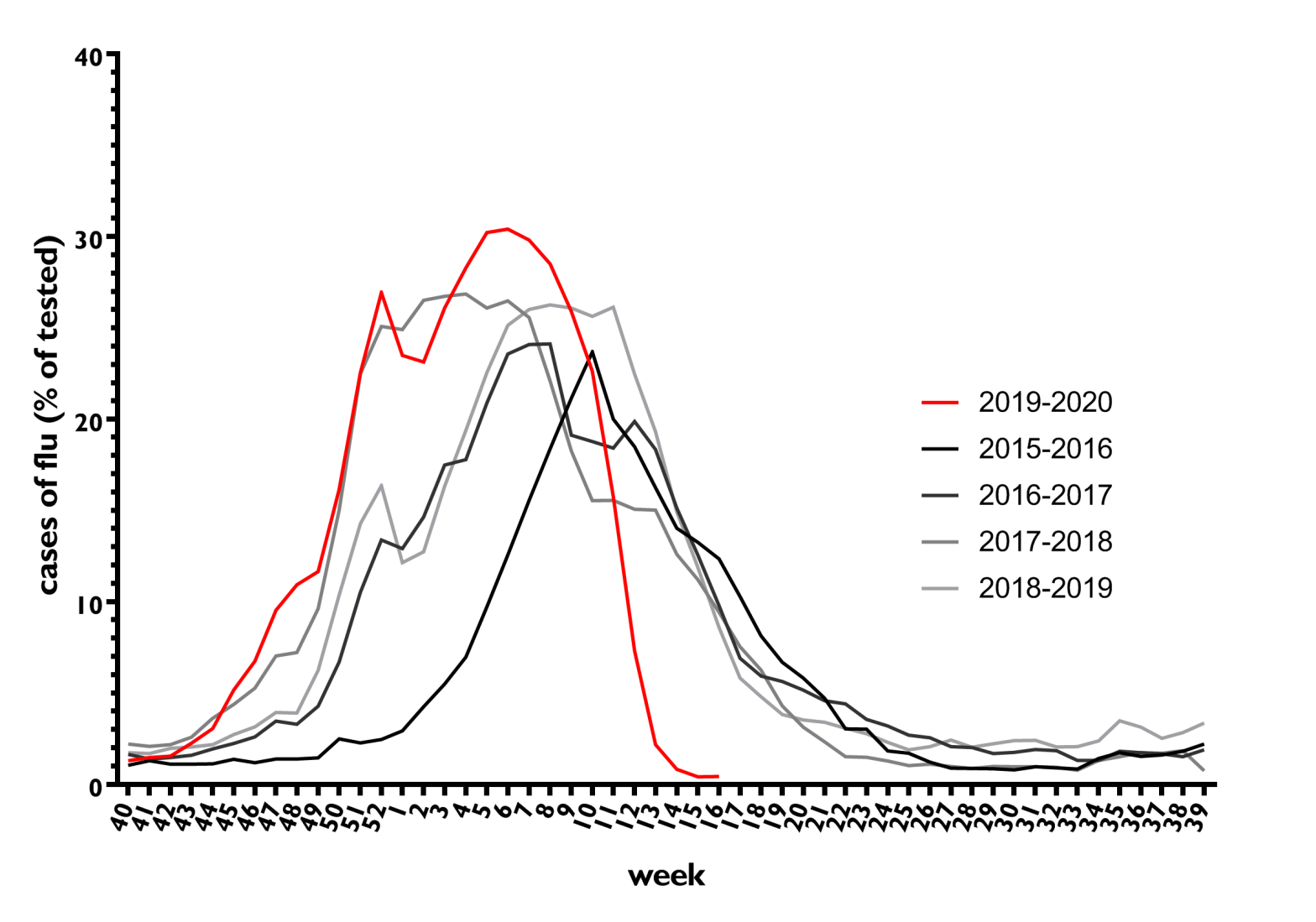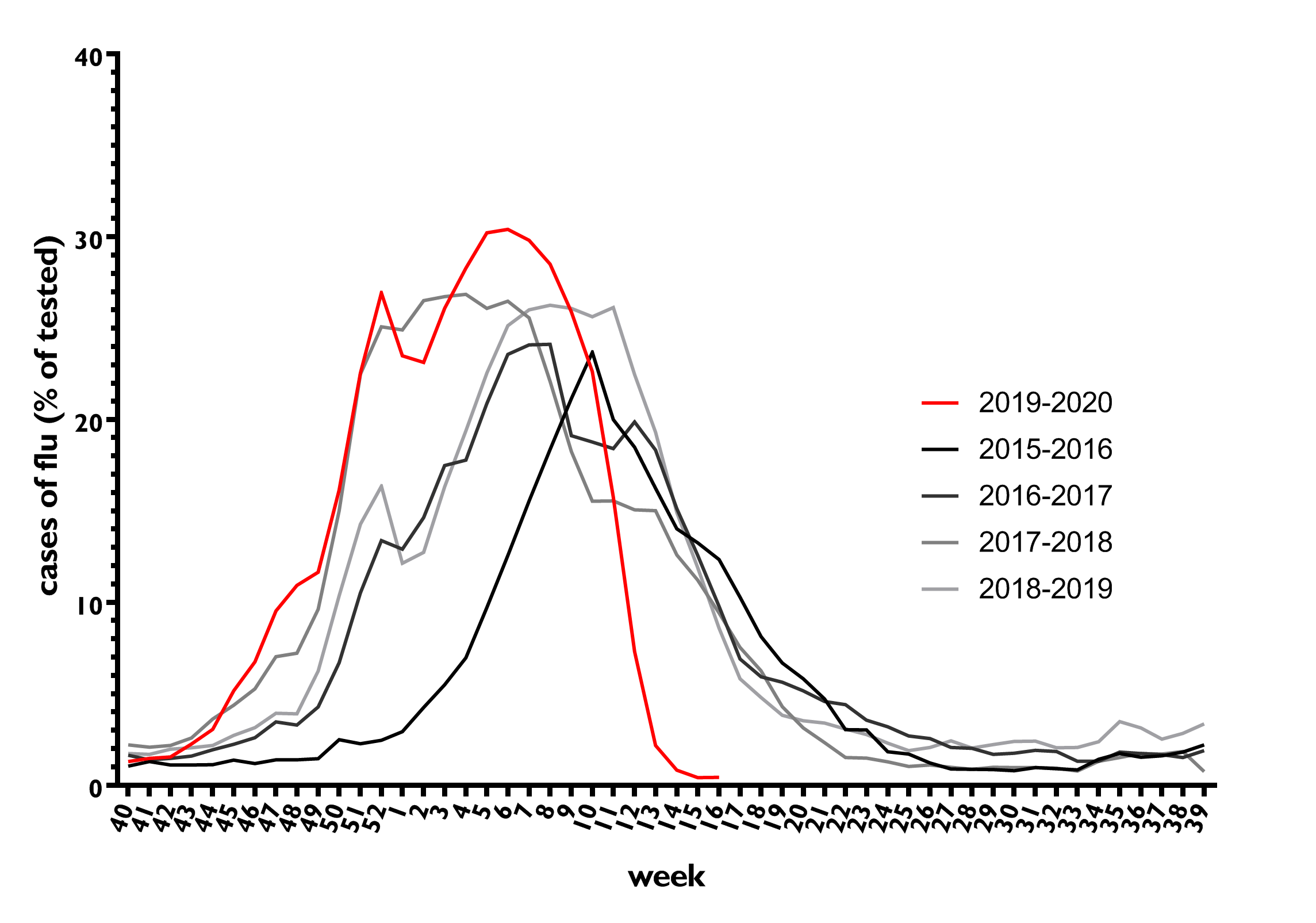- Health
The number of flu cases and deaths in 2020 is comparable to previous years
Key takeaway
The flu is a seasonal disease that begins during winter and generally peaks around February in the Northern Hemisphere. Based on statistics reported by the U.S. Centers for Disease Control and Prevention (CDC), the number of flu cases during the 2019-2020 season have been similar to at least the previous six years, as reported by clinical laboratories that conduct the testing. The rising numbers of COVID-19 cases and deaths do not reflect misidentification of flu cases and flu-related deaths, as suggested.
Reviewed content

Verdict:
Claim:
there are ZERO flu deaths and ZERO pneumonia deaths for the first time in history
Verdict detail
Factually inaccurate: The claim states that there are zero deaths of flu, directly contradicting data generated by hospitals and clinical laboratories, which are collected and reported by the U.S. Centers for Disease Control and Prevention.
Full Claim
So let me get this straight ... there are ZERO flu cases and ZERO pneumonia deaths for the first time in history? How is that possible?
Summary
A Facebook post claimed that there are “ZERO flu deaths and ZERO pneumonia deaths for the first time in history”. Given the current context of the COVID-19 pandemic, this statement could be interpreted by some people to mean that flu cases and flu-related deaths are being mislabeled as COVID-19 cases and deaths in order to inflate the magnitude of the pandemic (as shown by comments in the Facebook post’s thread).
This claim was made on April 12, 2020, during the 15th week of 2020, and is factually false as the CDC reports 380 flu-related deaths and 18,629 new, laboratory confirmed cases of flu that week.
Looking back to the data for earlier weeks, it appears that the proportion of people tested for flu whose results were positive throughout the 2019-2020 flu season is similar to the proportions in previous years (Figure 1). The proportion of positive cases detected by clinical laboratories peaked between the 6th and 8th week of 2020 before decreasing. This peak is expected because flu is a seasonal disease, peaking in winter and almost disappearing in the summer. Data since 1982 indicates that the number of flu cases typically peaks in February in the Northern Hemisphere.
It ought to be noted, however, that the proportion of positive flu tests dropped more sharply in April of the current season than in previous flu seasons. This phenomenon was also observed in other regions such as Singapore[1], Japan[2], and Australia and is therefore not limited to the U.S. Researchers from the Saw Swee Hock School of Public Health at the National University of Singapore have suggested that the prophylactic measures taken to curb the spread of SARS-CoV-2, such as hand washing, masks, and social distancing, have also contributed to a quicker termination of the current flu season[1]. Researchers from the University of Tokyo reached similar conclusions[2].


During week 15 of 2020, 380 flu-related deaths, not zero, were reported. The trajectory of deaths during the 2019-2020 flu season is similar to the curves in previous years, with the possible exception of the 2017-2018 season, which was particularly deadly (Figure 2). This trend is confirmed by other statistics provided by the CDC, including the cumulative number of hospitalizations, which represents the number of patients with laboratory-confirmed flu infections who were admitted to a hospital. These data also clearly show that 2020 has not been spared by the flu, as the number of individuals hospitalized with flu rose steadily during the first two months of the year. At week 15, the number of new hospitalizations reached a plateau, a pattern that occurs every flu season, although not necessarily during week 15.
In summary, clinical laboratories did record cases of flu and flu-related deaths during the 2019-2020 season, as well as during the two weeks preceding the time when this claim was posted (weeks 14 and 15). As of 27 April 2020, the CDC reported an estimated 39 to 56 million cases of flu in the U.S. during the 2019-2020 flu season. During the same period, flu accounted for an estimated 24,000 to 62,000 deaths in the country. The overall dynamic of the 2019-2020 flu season is comparable to previous years, with the exception of a sharper than usual drop in cases in April. Given that the flu is a respiratory disease, the ongoing social distancing instituted because of the COVID-19 pandemic is likely responsible for this drop.
Finally, comparisons of overall mortality in 2020—that is the number of deaths from all causes—with past years demonstrates that 2020 is seeing an unusual increase in the number of deaths in most countries hit by COVID-19. This further confirms that the cases and mortality attributed to COVID-19 is not due to a mislabeling of “normal” flu cases.
REFERENCES
- 1 – Soo et al. (2020) Decreased Influenza Incidence under COVID-19 Control Measures, Singapore. Emerging Infectious Diseases.
- 2 – Sakamoto et al. (2020) Seasonal Influenza Activity During the SARS-CoV-2 Outbreak in Japan. Journal of the American Medical Association.
UPDATE
29 April 2020: This review was updated to clarify that the claim was not referencing the entire 2020 flu season, and to provide more explanation for the sharp drop in diagnosed flu cases that occurred in April. We also received feedback from readers asking to clarify why the number of flu-related deaths in Figure 2 are different from the U.S. CDC estimates. This is because the numbers here represent confirmed flu-related deaths recorded by the U.S. National Center for Health Statistics, rather than an estimation



